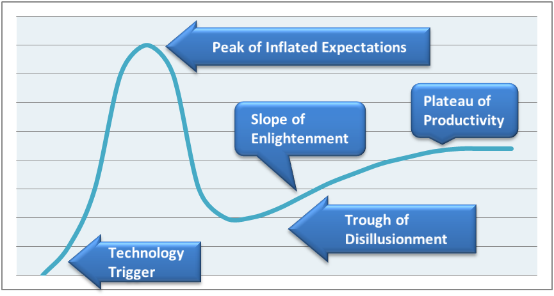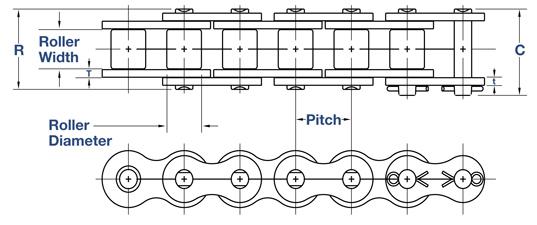Alanna recently put me onto this idea of how the innovation adoption cycle actually works. It’s an interesting way of understanding how innovation ripples across established practices.
Though it’s business focused, it demonstrates how even flexible businesses have trouble effectively adopting and harnessing technological innovation. Education is much more conservative and inflexible, so this process is weirdly distorted in ed-world where many people still think that a chalkboard is sufficient.
In ed-world that technology trigger is usually ignored, along with the hype, excitement and enthusiasm. A kind of wilful ignorance blinkers many educators from even looking at technology, it’s all just a fad. What finally drags them into it is the fact that what they’re doing in the classroom is sadly out of touch with what the rest of the world is doing.
While teachers complain about lining up at photocopiers but won’t consider alternatives, the rest of the world got excited about cloud based documents and moved online. Even as school departments worried over photocopying costs (and forests moaned under the weight of learning the way it has always been done), tech-hype excited businesses were frantically connecting up cloud based solutions and searching out efficiencies. In business, management is often the most agile, forward looking part of the enterprise; the early adopters. Business’s willingness to adapt and seek out efficiencies is usually a lead by example process. Educational leaders tend to get there by towing a conservative line, they’re not interested in actually changing anything.
Without the lead-by-example business approach, technological change in education only seems to happen when there is no other choice. When a disruptive technology is finally so overwhelmingly apparent that educational management is forced to consider it, they aren’t leading by example and the vast majority of the people within their organization don’t want it either. Status quo rather than improvement is the point of education.
When it comes to education, we begin in the trough and usually don’t get out of it:
We ignore the trigger and have none of the hype that encourages people to experiment and explore possibilities, there is no hope for new technology in the educational apparatus. Beyond the classroom there is hope, excitement and possibility before finally dropping into the trough of disillusionment. I’d argue that this range of emotion when exploring new technology allows early adopters a better chance to grasp what a new technology is capable of and allows them to eventually optimize their plateau of productivity.
In education we grudgingly begin in the trough, grumble about the entire process and then pick it up as poorly as possible, never exploring it, never revelling in the possibilities it might offer. When it gets difficult we drop it, having never wanted to do it in the first place. The poor support around embracing new technologies is just another symptom of this.
If you wanted a perfect example of how not to effectively integrate innovative technology, you need look no further than the education system. There are outliers within the system who push against the morass of conservative norms that manage and run education, but they struggle to find support, often having to find indirect ways to explore and integrate new technology.
As long as schools are administrated by the most conservative elements in education (academia loves conservatism), we will always struggle to stay abreast of innovation, whether it be technological or otherwise.
Two Recent Examples#1: I got an HTC Vive virtual reality headset for the computer lab. It’s an uphill struggle to get any staff to try it (students? No problem). The general comment I get is, “what did that cost?” My standard reply is, “less than your photocopying budget.” The Board is unable to connect the SteamVR software needed to update the drivers and programs on the headset, so I’m trucking the desktop home each week to update it at home.
Even during those rare moments when we do get current technology in, there is no hype, only criticism and doubt. For someone who gets excited about the possibilities of technology, this is a very exhausting environment to be in.
#2: We requested a Glowforge desktop 3d laser cutter in for the tech-design lab. Even though it comes equipped with Hepa air filters and doesn’t require any exhaust, we were stymied by board safety people whose default position is ‘no’, regardless of any facts we could produce.



































